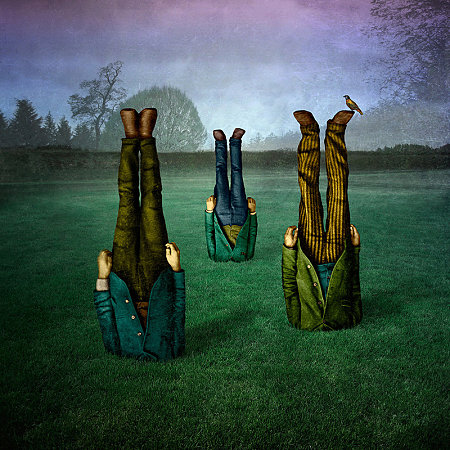
Global Positions
*
It seems that I was born for road trips. My first occurred not long after my birth, when my mother and father, along with my two brothers, set out from the Air Force base in Washington State, where my father had been stationed after his stint in Korea, to our new home in Pennsylvania. Because I was too young to remember, my father worked most of my life to convince me that I was along with them—that I, too, traveled from Washington to Mexico, San Francisco to Sacramento, Las Vegas to Flagstaff, Memphis to Cincinnati. While I am mysteriously absent from slides and photographs, evidence of my family’s part in this journey does exist, and I’ve pored through the images and constructed the country and my history from them. Chris recently discovered two photos of my mother holding an infant that she’s certain must be me. I’ve hesitantly accepted her evidence.
On an isolated road near Yosemite, my mother poses next to the trunk of a fallen sequoia, my brother touching her jeans as her hand rests on his short-cropped hair. In Arizona, my oldest brother stands astride a length of petrified wood, his cowboy hat cocked, fringe dangling from his buckskin jacket. My father, in white t-shirt and desert-tan fatigues, pauses beside a national park sign—Entering Grand Canyon. Throughout the trip, he photographed North America, recognizing, even at the age of 33, the value of heritage and posterity: the snow packed roads of Mt. Rainier, the dusty and crowded streets of Reno, the isolated morning fields of Coeur d’Alene, the rocky coast of Baja California, the black bears of Yellowstone.
In 1962, our family took another trip—a shorter distance but for me, at the age of seven, a more memorable one. This time we went from Philadelphia to Detroit. Passing through the Blue Mountain, Laurel Hill, and the Tuscarora tunnels in central Pennsylvania, I became aware of the immensity of the landscape as each mountain rose above the steady and constant turnpike, or we entered the tunnels’ dark mouths and the claustrophobic roadways within. These contradictions occurred to me even as a child, as we skirted Lake Erie en route to Toledo, then north to the western edge of Lake St. Clair. Even as I followed the map through the suburbs of Detroit, I sensed there was more to it. Lake St. Clair, as vast as it seemed, was dwarfed by Lake Erie, and even more so by Lake Huron. I reflected on the paradoxical landscape for years afterward: the tunnels, the lakes, the bridges—the revealed and the concealed, the immense and the minute, the exhilarating and the suffocating.
“Will we be driving to Huron?” I asked my father.
“What do you think?” he replied.
I didn’t need to answer. I knew that Detroit was as far as we’d go. What was beyond Detroit, after all? Canada. And beyond that? I could only imagine. My father had been driving for more than twelve hours, nearly 600 miles according to the map legend. And although maps don’t lie, they eventually end, sometimes like a dream or a vision, and even my father had his limits. Even he could become road weary at the Canadian border, or the northernmost shore of Lake Michigan.
*
Chris tells me we’ll soon be approaching a river and a bridge that crosses over. This I can already infer from the thin jagged line segmenting the interstate on the digital screen, even without having read the manual. Still, I’m less aware of most geographic features—the ridges, the canyons, the park lands, the urban skylines—since our GPS companion hasn’t spoken to us for miles. Of course, if I’d had the foresight to study the route ahead of time, I might have recognized the river before the announcement of its existence. “Where are we?” my father would have asked, encouraging a more thoughtful observation, but our GPS doesn’t encourage speculation. Certainty, not guesswork, is its task.
Often, my wife expresses a desire to become lost, to take a course contrary to the one called out by the voice in the box attached to our windshield. “I wonder where that leads,” she’ll muse, focusing on a two-lane road that bends and rolls, rises and falls until it vanishes in the distance—a road that our GPS, consumed by its own certainty, would never suggest we follow. Still, my wife tends to be more adventurous than our GPS (a trait she shares with my father) and more adventurous than I am, for that matter. I read maps with roads that have beginnings and ends. Even though I wonder what lies at their ends, I also wonder if I have the courage to follow them.
Chris also envisions the artificial intelligence embedded in our unit as genuine intelligence that can be trained—if we take this back road as opposed to the one suggested, our GPS will eventually understand and accept her sense of adventure, perhaps adopting its own. But I have my doubts. As far as adventure goes, at least I can learn. I stumble onto a digital feature that allows us to select a number of variations for our journey: quick routes, short routes, tolls, no tolls, least congested, most isolated, safe or risky. Soon, I discover that our options are not true options, just more avenues by which our GPS seizes control. We make a choice, but the GPS calls the shots.
